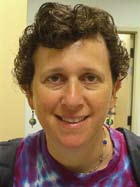 Alyssa Goodman. Photo by Keith Kie.
Alyssa Goodman. Photo by Keith Kie.
Within the “Star Formation ” program, Alyssa Goodman, of the Harvard/Smithsonian Center for Astrophysics, ran a workshop on large surveys of nearby star formation regions. Goodman, a program organizer, is an observer, who heads the COMPLETE Survey.
The workshop aimed to bring together survey leaders — astronomers who use mostly radio telescopes to collect data on molecular-hydrogen clouds and star formation in large swaths of the actual sky — with theorists, especially simulators who are modeling star formation via computer, to understand better the star-birthing process.
In an exercise worthy of the most arcane postmodernist fantasy, the observers and the simulators conferred in order to adjust the simulations, which operate (inside computers, so to speak) in a three-dimensional representational space evolving over millions of years, to look the way the simulations would in the two-dimensional representation plane of the “real” world that the observer now “sees” (though “see” is even more a misnomer with radio astronomy than with optical astronomy). To determine whether the simulations fit the observations, the “picture” produced by the simulations has to be modified to appear the way it would if an earth-bound observer were now surveying the simulated space via telescope.
Another goal of the workshop was for both observers and theorists “to understand the observational biases of the different kinds of surveys,” according to Goodman. “There were questions about what the mass spectrum of gas is before it actually forms stars in conjunction with different models that were being discussed in the program,” she said. “The theories make different predictions about that, and so people were very interested in what kinds of constraints are entailed in these large statistical surveys.”
The workshop’s benefits for theorists are clear, so what benefit is there for observers?
“First of all,” said Goodman, “we get to talk to each other, which is very valuable. Second, we get to hear what the theorists are thinking about our observations."
“For observers like me, there are things that we can measure that we don’t appreciate are so critically important."
“It turned out that the theorists were really obsessed with this idea that changes in the equation of the state of the gas could cause very subtle differences in the density profile of particular blobs of gas that were forming stars. We can measure density profiles fairly accurately, but they didn’t realize (and we didn’t realize they didn’t realize) that we can also measure the temperature profile pretty well, though it is very difficult to do and very uncertain. Back in my own group, we are now focusing on what we can do to better quantify the uncertainty in these temperature and density profiles because this little factoid is so important to the theorists."
“From reading the literature, we didn’t appreciate that need,” she said. “It is hard to tell from the literature the difference between a question and a super-important question.”
Talking face to face does have advantages for doing science, as Goodman’s example shows.
 |
Click above to play COMPLETE Survey of Star-Forming Regions or watch at http://online.kitp.ucsb.edu/online/stars07/goodman2/
